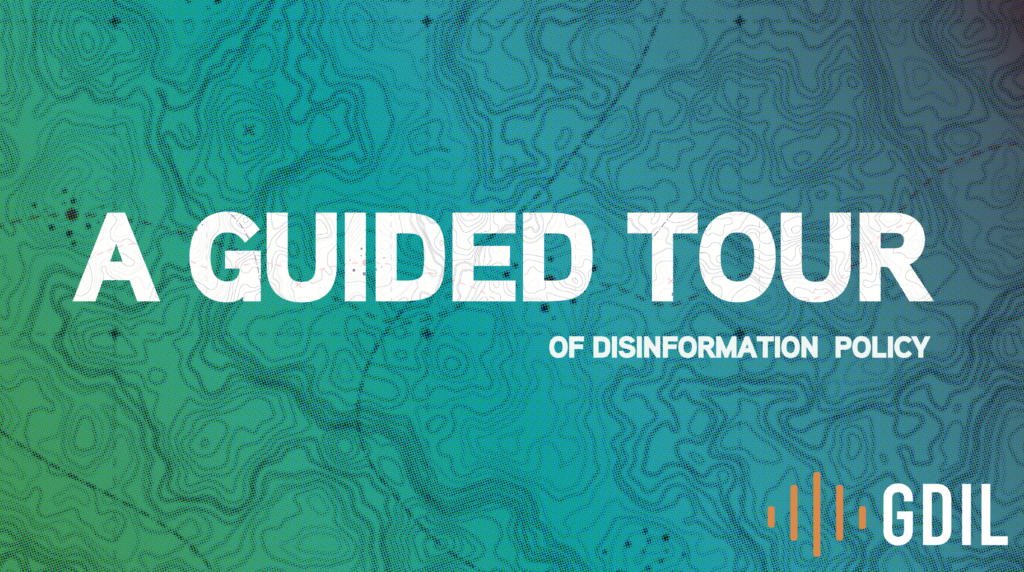A Guided Tour of Disinformation Policy: Framework and Legal Action
newsletter via Feeds on Inoreader 2024-01-24
Summary:

By Riley Galligher and Samantha Tanner
This is part 4 of our series “A Guided Tour of Disinformation Policy”. To read the first part, click here.
Disinformation Policy: Identifying Landmarks
In the interest of taking you on this guided tour of disinformation policy, we need to pick a starting point for analyzing this quickly evolving policy issue area. We have organized the various methods of combating disinformation with policy into three general categories: legal action, content moderation, and media literacy initiatives. These three categories stand out as (1) the most prevalent methods of combating disinformation among existing policy efforts and (2) the most common way scholars have categorized policies.
As we demonstrated in the discussion surrounding definitions of disinformation, crafting effective disinformation policy is a nuanced effort and the same complexity affects policymaking and policy enforcement. Scholars in the field have taken several different approaches to categorizing disinformation policy, leaving us with a number of ways to think about disinformation policy proposals and its objectives. Some researchers attempt to group policies by variables such as actor, target, agency, field, enforcement mechanism, etc. Focusing on specific variables such as these to guide policy organization is a valuable approach and can offer deep insights into specific policy issues and analysis. However these detailed approaches to categorizing disinformation policy are not well suited for the aims of this guided tour. Moreover they leave the existing pool of literature on disinformation policy without a common vocabulary enabling broader discussion and analysis of disinformation policy.
From this rather unconsolidated group of approaches among the existing literature on disinformation policy, we have been able to organize the majority of policy methods into three categories: legal action, content moderation, and media literacy.
Legal Action includes legislation passed by governments to punish actors that produce and disseminate disinformation or platforms that distribute it.
Content Moderation includes legislation or policies designed to prevent the production and dissemination of disinformation by censoring disinformation. This can be done by the government, platforms, or companies.
Media Literacy includes initiatives to educate citizens on how to identify disinformation and increase resilience and critical thinking among the public. It also includes initiatives to verify information on media sites and flag disinformation to the public.
In creating these categories, we tested their compatibility with existing groupings of disinformation policies or their methods. We found these categories encompass the largest number of existing categorizations of disinformation policy. Furthermore, it has a clear line of reasoning that can be identified and followed across scholars and existing thought in the field. Three examples of this compatibility among the literature with our categories are from:
- Tackling the Information Crisis[1]
- Legal Action: Direct Regulation
- Content Moderation: Self-Regulation and Co-Regulation
- Media Literacy: Audience Education
- Institutional Counter Disinformation Strategies[2]
- Legal Action: Speech Law and Censorship
- Content Moderation: Algorithmic Filter
- Media Literacy: Refutation, Exposure of Inauthenticity, and Alternative Narrative
- Government Responses to Disinformation[3]
- Legal Action: Legal and Regulatory Responses
- Content Moderation: Media and Civic Responses
- Media Literacy: Direct Response and Public Communication
- Tackling Disinformation: EU Regulation of the Digital Space[4]
- Legal Action: Direct Regulation
- Content Moderation: Self-Regulation and Co-Regulation
- Media Literacy: Audience-Centered Approaches: Fact-Checking and Media Literacy
These are just four examples of how the organization of policy approaches and methods in the literature surrounding disinformation policy varies. Despite this variation, our categorizations are broadly compatible with the frameworks.. We expect these categories will remain compatible with the disinformation policy of tomorrow and continue to provide a valuable theoretical framework to understand future policy developments.
As descr